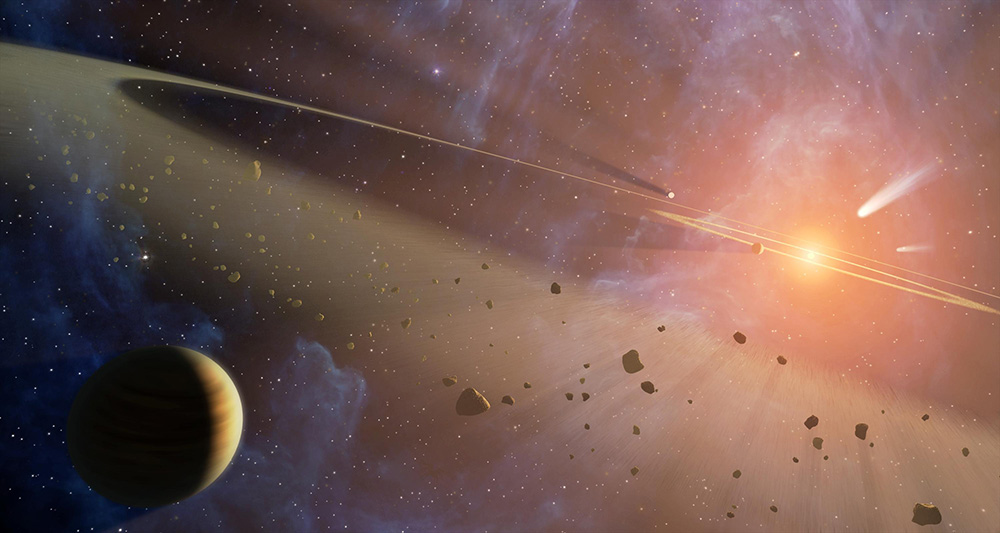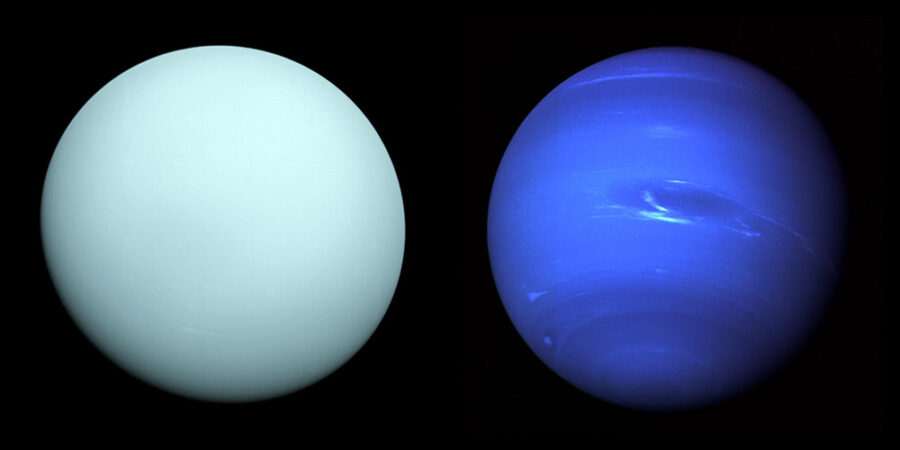Conventional planet formation scenarios have Neptune and Uranus forming closer to the Sun. But a new study shows that the ice giant planets could have formed right where they are now.

NASA / JPL-Caltech
Reconstructing the events that led to the present configuration of planets in the solar system is a formidable task. The orderly perennial motions emerged from the hectic conditions within the newborn protoplanetary disk, marked by violent collisions and radial migrations of forming protoplanets. Planet by planet, scientists have tried to put together the pieces of the puzzle. How do Uranus and Neptune, the outermost planets of the solar system, fit in?
The two ice giants are probably the most enigmatic planets in the solar system. Their distances (20 and 30 times the Earth's distance from the Sun, respectively) and unique mass regime (between that of the gas giants and the terrestrial planets) challenge the models. Scientists aren't sure how or where the two planets formed, but evidence has until recently suggested that Uranus and Neptune could not have formed where they are today.
Now, a new study contradicts those arguments, claiming that the planets could, in fact, have formed at their current locations. The intriguing result, to appear in The Astrophysical Journal (preprint available here), provides an alternative to the migration scenario.
"I don't say they didn't form farther in; they could also have formed farther out," says study team member Ravit Helled (University of Zurich, Switzerland). "But we cannot say anymore that they cannot form in situ — yes, they can!"
Pebbles to the Rescue
The current picture of planet formation looks like this: Planets come together out of a protoplanetary disk consisting of gas and dust grains. The grains collide and grow into pebbles, reaching centimeter sizes. Under certain conditions, pebbles further clump into planetesimals with characteristic sizes of a hundred kilometers and ultimately into planetary cores.
If cores reached a large enough mass, they would start gathering gas from the disk. Therefore, giant planets had to form within several million years, before the gaseous disk dissipated. However, planetesimal growth was slower farther from the Sun. At their current distances, Uranus and Neptune wouldn’t have had time to grow, according to this scenario.
But that scenario neglects the role of pebbles in building up a planet. The pebbles would have drifted inward from the solar system’s outskirts toward the Sun, and on their way they would have fed planetary embryos. With a steady pebble intake, the cores of Uranus and Neptune could have grown to the necessary mass well before the disk’s gas had dissipated.
“The formation time scale problem that was there for a very long time, from my perspective, no longer exists,” says Helled.
Helled’s team ran 24 versions of their simulation, following the accretion of pebbles as well as hydrogen and helium gas onto a single, massive planetary core. A few versions could reproduce the giant’s total mass as well as the mass of its gaseous envelope.
However, the scientists also found that planets in most simulation scenarios were missing heavy elements, up to 3 Earth masses’ worth. Giant impacts might plausibly have delivered this missing mass, the team suggests, since impacts are already known to have played an important role in the formation of many (if not all) the planets in the solar system.
The new study traces the growth of the two planets individually. However, Helled says that they should improve upon this simplified approach and look at the simultaneous formation of the two and ultimately of all four giant planets.
Not So Simple!
Planetary scientist André Izidoro (Rice University), who was not involved in the study, cautions that migration is hard to avoid. "As planets grow, especially when they become larger than one Earth or Mars mass, they start to move around," says Izidoro.
Indeed, simulations have demonstrated that Uranus and Neptune could have formed from a series of collisions among migrating protoplanets. So, which scenario describes what really happened?

NASA / JPL-Caltech
Direct chemical traces of migration are difficult to find, but the planetary configuration itself provides some clues. For example, a population of planetesimals beyond the orbit of Neptune, known as the Kuiper Belt, clusters at certain distances from the Sun. Scientists suspect that much of this structure appeared as a result of Neptune's migration.
Many open questions remain about Uranus and Neptune, because they lack the close-up scrutiny that we’ve made of other planets. We don’t accurately know the masses of their gaseous envelopes, for example, which are among the many ingredients in simulations of their formation. Though a mission to the ice giants that would answer questions like these has undergone consideration, nothing has yet gotten off the drawing board.
Regardless of what any such mission finds, the final answer to the question of the ice giants’ origin will likely bring together all kinds of different processes and scenarios. As both Helled and Izidoro repeatedly emphasized: It’s complicated.
 1
1









Comments
Rod
March 30, 2022 at 8:08 am
Thanks for the report and reference paper. The 18-page paper states "We simulate the in-situ formation of Uranus and Neptune via pebble accretion using the formation model presented in VH20...to simulate the formation of giant planets. The simulations begin with a heavy-element core with a mass of Micore = 0.01M⊕ and a negligible envelope." My note, the paper states, "2.1. Accretion rates The heavy-element accretion rate is a key factor when modeling the formation of Uranus and Neptune..."
I am glad to read assumptions clearly presented. Variations in the simulations result in dramatic differences compared to what we see today in the solar system.
You must be logged in to post a comment.
You must be logged in to post a comment.